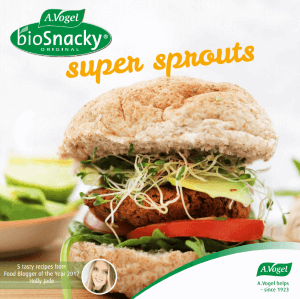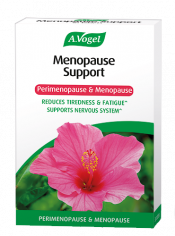Read the full video transcript below
Today's topic
Hello and welcome to my weekly video blog, today from the A.Vogel kitchen. And today, on the A.Vogel Talks Menopause, I'm going to be giving you one of my little secrets for healthy diet during the winter.
Now, up here in Scotland, the nights are starting to draw in and I know it won't be long until autumn and winter arrives. And at this time of the year, I do like to check my diet just to make sure that I'm still eating healthily, because like everybody else, I do slip up now and again. But I also want to start planning for my winter diet.
Now, for me during the summer, I love salads. I could eat salad for breakfast, lunch, and dinner, and I have no problems with them at all. But for me in the winter, the thought of eating a plate of cold food when it's wet and windy just does not appeal to me at all. And I love my food, I have to be happy eating my food.
So, I'm going to tell you a little secret. I don't like lettuce. So for me, lettuce especially in the winter is an absolute no, no, but what if I told you that you could have something that's far better than lettuce. Because to be honest, lettuce, there's very little nutrition in it. It's just a little bit of fibre and lots of water.
What can you grow that's four times more nutritious than lettuce?
But what if I told you there was something you could grow in your own kitchen for next to nothing that's at least four times more nutritious than lettuce and you only have to eat a quarter of the amount? So you could have a tiny little bit on a plate, and that will give you a huge percent of your daily nutrition allowance. It sounds absolutely fabulous, doesn't it?
My tip for a healthy diet during winter is...
And here it is, this is about growing and sprouting your own seeds and this is something that I've done for many, many years. My mum introduced me to them whilst I was still a teenager. So it's something that I have carried on for a long, long time.
Sprouts - easy to grow and jam-packed full of vitamins and minerals
Now, the great thing about these sprouts is that they're very easy to grow and I'll tell you how shortly. But it's just an absolutely jam-packed of vitamins and minerals. And if you are growing a few different varieties, you're going to have just about the complete range of everything. And we know that once these little seeds start to sprout, that the nutritional content such as your vitamins A, B, and C can rise over 20% in just a few days, and that's absolutely amazing.
Enzymes
The other thing that these sprouts have are something called enzymes in them. Now, enzymes are really important for our diet and for our digestion. You have something fresh and raw at the beginning of each meal which is going to provide you with enzymes, and those enzymes will help you to digest the rest of your meal more effectively and more comfortably.
And one of the reasons that so many people today have digestive problems is that they don't have that little bite of fresh foods at the start of every meal. So, this is one of the things that I do normally, certainly with lunch and dinner is that I make sure that I have a little bite of something fresh before I start the rest of my meal.
Recipes
So what I thought I would do today is just show you a couple of recipes that I use myself and other things that you can use them for. So, today, I have got some Alfalfa. Alfalfa is great, it's nearly a complete protein. It's absolutely full of vitamins A and C and it's got zinc. It's got magnesium and it's absolutely a fabulous food to add into your daily diet.
Crunchy salad - no lettuce
So all I would do, I've got a little bowl of salad here, no lettuce, just a few green leaves then it's full of tomatoes and peppers and red onions. And all I would do is just take a few bits here and just sprinkle them all over really nicely, and a few more.
And I've also grown some Mung Beans and Mung Beans are great because they are crunchy. So they're going to give some lovely texture to your salad, but they are full of protein, too.
And you will see that if you start to grow the seeds, all the little husks come off as well. It's a great form of fibre and we do know that in the menopause, our digestion can get a bit sluggish. So this is going to give us a little bit of extra fibre every time that we eat them. And again, I would just put a few of the sprouts on my salad, mix it up, and then I would put on one of my favorite salad dressings.
Is that really Mung Beans?
Now, you may be sitting there going, "Oh, is that Mung Beans. They don't look like the Mung Beans I get to my supermarket." These are how Mung Beans are supposed to look. The great long white Mung Beans that you get in the supermarket are commercially grown and they're force fed carbon dioxide to bleach them and to make them straight. So if you want real true Mung Beans, this is what they look like here.
Apple, peanut butter & red clover snack
The other snack might sound a bit weird is peanut butter and apple. Now, you can use peanut butter. If you do, it's really important to make sure it's organic, there is no sugar in it, and there is no palm oil in it. All we want is a little bit of salt, if necessary, and the peanut butter.
If you're not keen on peanut butter you can use other nut butters such as almond butter or cashew nut butter or hazelnut butter or one of the next ones. And all I would do with this one, and I have grown some Red Clover, is I would just put a tiny little topping on each one.
And this is a fabulous snack for when you get the mid-afternoon sweet cravings, because you'll get a little bit of sweetness from the apple. You'll get the fibre so it will be a slow release sugar. You're going to get protein and fat from the peanut butter and that is going to stabilize your blood sugars, and you're gonna get a lovely little hit of some extra vitamins and minerals from the sprouts. And this is great to keep you going until you actually get home and you have time for your dinner.
Cream cheese, sprouts & crackers
If you do fancy a little bit more of a carbohydrate-y snack, you can look at bread, toast, and crackers of some kind. I like mine with a little bit of cream cheese, but you could put cottage cheese on it. I'm a great marmite fan, so I would actually a little bit of marmite on there first just to give it a little bit of added crunch.
With these again, we could go with Alfalfa, just sprinkle a few on the top. We could go with little bits of the Red Clover, and if you wanted extra crunch, you could put a few of the Mung Beans. Just absolutely fabulous, great snack, and again, that's another one that will keep you absolutely full until it's time for your next meal.

For more tasty recipes, download our brand new bioSnacky recipe ebook!These tasty, easy recipes come from Food Blogger of the Year 2017, Holly Jade. |
How do you grow the sprouts?
So how do you grow them? It's really easy, and for those of you who say, "I don't have time for that," 30 seconds twice a day is all it takes.
You can either use a 3-tier germinators or if you're not quite sure what to do, you can start off with one of these jars. They don't take long. It's Thursday today, I'm filming this on Thursday afternoon, and I started these on Sunday afternoon. So it would only take a few days to get them going, and they really don't take long.
You just put the seeds on the tray and you water them twice a day, rinse them twice a day. Once they're ready, you can use them. The rest of them, you can just put them in the fridge, and use them for later.
What can you do with them?
You've also got them in the fridge, so if you've had these kind of snacks one day, another day you could use them to put on your baked potatoes. You could put them as a garnish on soup. Don't cook them with the soup, though. Just put them on the top, sprinkle them on the top because the heat will kill all the enzymes which are what you're wanting. You can put them in sandwiches.
So you could have instead of bacon, lettuce, and tomato, you could have bacon and alfalfa and tomato salad. You could have an egg and red clover salad. And what I do is if after the three days I have any left, rather than throwing them out, I will put them into my soup just for added fibre, for added protein, and for the extra minerals as well.
So these can be used right up until the last minute. They're very cost-effective and as I say, you grow them in the winter and it's great for giving you that tiny little bits of fresh foods when everything's dark and miserable around about us.
Let me know how you get on
So I hope that's giving you a nice idea, you know. Why don't you try them and see how you get on and let me know? And I'll see you next week for another edition of A.Vogel Talks Menopause.








